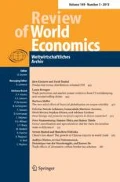Zusammenfassung
Ein Test der Effizienz von WarenterminmÄrkten. — In Reaktion auf die UNCTAD-PlÄne zur Stabilisierung von Rohstoffpreisen durch behördliche Ausgleichslager hat sich die Diskussion um WarenterminmÄrkte als alternative, marktkonforme Stabilisierungsinstrumente erneut entfacht. Eine wesentliche Voraussetzung für den stabilisierenden EinfluΒ der TermingeschÄfte auf die Kassapreise von Rohstoffen ist, daΒ die TerminmÄrkte «effizient» sind, d. h., die Terminmarktpreise sÄmtliche jeweilig verfügbare Information widerspiegeln. In diesem Aufsatz wird die Effizienz der TerminmÄrkte für fünf wichtige Rohstoffe (Kupfer, Zinn, Zucker, Kakao und Kaffee) des UNCTAD-Programms getestet. Dazu werden ARIMAZeitreihenmodelle der Kassapreise geschÄtzt und die Entwicklungen ex post vorhergesagt. Die so gewonnenen Ex-post-Prognosen sind effiziente Vorhersagen, da die Modelle alle systematischen Komponenten einer Zeitreihe erfassen, so daΒ der unerklÄrte Rest zufallsverteilt ist. Ein Vergleich zwischen dem mittleren quadrierten Vorhersageirrtum der Prognosemodelle und dem der WarenterminmÄrkte zeigt, daΒ die TerminmÄrkte in allen FÄllen künftige Entwicklungen ebensogut oder besser anzeigen als die Modelle. Folglich kann die Hypothese, daΒ die untersuchten MÄrkte im oben beschriebenen Sinn effizient sind, nicht verworfen werden.
Résumé
Un test de l’efficacité des marchés á terme des matières premières. — cet article nous faisons un test »demi-fort« sur l’efficacité de marché pour cinq matières — le cuivre, l’étain, le sucre, le cacao et le café — pour lesquelles la CNUCED a proposé de stabiliser les prix par des schemes des stocks régulateurs. Les résultats indiquent que, pour la période observée, on ne peut pas refuser 1’ hypothèse que les marchés á terme de ces matières premières sont efficaces dans le sens que le marché emploie toutes les informations publiquement disponibles en formant les expectatives sur les prix au comptant futurs. Nous concluons que la stabilisation des prix au comptant de quelques matières premières pourrait Être regardée comme alternative favorable vis-á-vis les schemes des stocks régulateurs de la CNUCED.
Resumen
El test de la eficiencia de mercados a futuro de productos primarios. — En este articulo se realiza un test de eficiencia de mercado de forma »semi-fuerte« para cinco productos, espedficamente, cobre estafio, azücar, cacao, y café, cuyos precios UNCTAD ha propuesto estabilizar a través de esquemas de stocks amortiguadores. Los resultados indican que para el periodo estudiado, la hipötesis de que los mercados a futuro para estos productos son eflcientes en el sentido de que el mercado emplea toda la informacion que se puede obtener püblicamente, informando sobre expectativas de los precios puntuales futuros, no puede ser rechazada. Se concluye entonces, que la estabilización de los precios puntuales para algunos productos primarios a través de mercados a futuro puede ser considerada como una alternativa favorable frente a los esquemas de Stocks amortiguadores de UNCTAD.
References
Bilson, John F. O., andRichard M. Levich,A Test of the Forecasting Efficiency of the Forward Exchange Rate. New York University, Graduate School of Business Administration, Working Paper Series, No. 61, New York, 1977.
Box,George E. P., andGwilym Jenkins,Time Series Analysis: Forecasting and Control. Ho] den-Day Series in Time Series Analysis, San Francisco, 1971.
Cargill,Thomas F., andGordon C. Rausser, “Future Price Behavior as a Stochastic Process”.American Statistical Association Proceedings, Business and Economic Statistics Section, August 1969, pp. 438–445.
—, and —, and -, “ Temporal Price Behavior in Commodity Futures Markets”.The Journal of Finance, Vol. 30, New York, 1975, pp. 1043–1053.
Danthine, Jean-Pierre, “Information, Futures Prices and Stabilizing Speculation”.Journal of Economic Theory, Vol. 17, New York, 1978, pp. 79–98.
Donges, Juergen B., “UNCTAD’s Integrated Programme for Commodities: Economic Implications and Europe’s Response”. In:Le rÔle de l’Europe dans le nouvel ordre économique international.Université de Bruxelles, Bruxelles, 1979, pp. 129–150.
Dower, Roger C, andRobert C. Anderson, “Futures Markets: An Alternative for Stabilizing Secondary Materials Markets ?”Resources Policy, Vol. 3, Guildford 1977. PP. 230–236.
Fama, Eugene F., “Efficient Capital Markets: A Review of Theory and Empirical Work”.The Journal of Finance, Vol. 25, Worcester, 1970, pp. 383–417.
Houthakker, Hendrik S., Systematic and Random Elements in Short-Term Price Movements”.The American Economic Review, Vol. 51, Evanston, 1961,Papers and Proceedings, pp. 164–172.
Kofi, Tetteh A., “A Framework for Comparing the Efficiency of Futures Markets”.American Journal of Agricultural Economics, Vol. 55, Menasha, 1973, pp. 584–594.
Labys, Walter C, andC. W. T. Granger,Speculation, Hedging and Commodity Price Forecasts. Studies in Business, Industry and Technology, Lexington, 1970.
Leuthold, Raymond M., “Random Walk and Price Trends: The Live Cattle Futures Market”.The Journal of Finance, Vol. 27, Worcester, 1972, pp. 879–889.
—, andPeter A. Hartmann, “A Semi-Strong Form Evaluation of the Efficiency of the Hog Futures Market”.American Journal of Agricultural Economics, Vol. 61, Menasha, 1979, pp. 482–489.
Nelson,Charles R.,Applied Time Series Analysis for Managerial Forecasting. San Francisco, 1973.
Reidy,B., and John Edwards (Eds.),Guide to World Commodity Markets. London, 1977.
Smidt, Seymour, “A Test of the Serial Independence of Price Changes in Soybean Futures”.Food Research Institute Studies, Vol. 5, Stanford, 1965, pp. 117–136.
Stevenson, Richard A., andRobert M. Bear, “Commodity Futures: Trends or Random Walk?”The Journal of Finance, Vol. 25, Worcester, 1970, pp. 65–81.
Streit, Manfred E., “On the Use of Futures Markets for Stabilization Purposes”.WeltwirtschaΒliches Archiv, Vol. 116, 1980, pp. 493–513.
Tomek, William G., andRoger W. Gray, “ Temporal Relationships among Prices on Commodity Futures Markets: Their Allocative and Stabilizing Roles”.American Journal of Agricultural Economics, Vol. 52, Menasha, 1970, pp. 372–380.
About this article
Cite this article
Gupta, S., Mayer, T. A test of the efficiency of futures markets in commodities. Weltwirtschaftliches Archiv 117, 661–671 (1981). https://doi.org/10.1007/BF02708116
Issue Date:
DOI: https://doi.org/10.1007/BF02708116

